
Math Topics
Learning Support
Professional
![]()
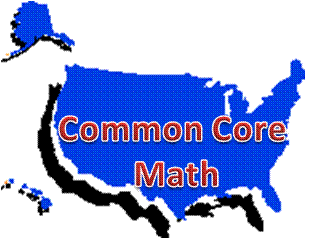
Many states across the country have math standards based on the Common Core Math Standards. As such, educators need teaching and learning resources that pair with the goals of the standards. The good news is that CT4ME is a prime source from which to select resources for your state or Common Core exam.
Please note that many states have their own state exam, rather than using a specific Common Core exam. It's important to note, however, that the CCSS have had staying power. Although 46 of 50 states originally adopted them, "A lot of states have renamed the standards or even “repealed” them—but in almost every state, what is in place now looks an awful lot like the Common Core as originally written" (Polikoff, Petrilli, & Loveless, 2020, p. 75).
As such, the following resources in our Common Core section will help learners in all states.
Notes and General Resources
Strands: Each cluster below provides general resources for it and then domain specific resources. Each domain includes technology investigations, multiple choice and constructed response exercises, and performance tasks. Students should be able to review on their own using the resources.
The standards for mathematical practice, as they apply, are noted within many of those resources.
There are eight standards for mathematical practice within the Common Core State Standards (CCSS) for Mathematics (2010):
![]() Some
files in our collection are in pdf format. If needed, download
Adobe
Acrobat Reader, free software for viewing and printing PDF files.
Some
files in our collection are in pdf format. If needed, download
Adobe
Acrobat Reader, free software for viewing and printing PDF files.
![]() To
interact with virtual manipulatives included within the
Wolfram Demonstrations Project:
Download the free Wolfram player.
To
interact with virtual manipulatives included within the
Wolfram Demonstrations Project:
Download the free Wolfram player.
![]() You
might need to download Java, a free
plug-in to interact with virtual manipulative applets.
You
might need to download Java, a free
plug-in to interact with virtual manipulative applets.
Note: See Java's Help information on how to enable Java in your web browser, if an applet does not run after an installation.
Note: Resources also include links to online videos. If you are concerned about students using YouTube videos where they are found, consider using SafeShare.tv, which is promoted as the "safest way to watch and share YouTube videos." Users enter the URL of a YouTube video and the site generates a safe link.
Note: Newer versions of virtual manipulatives are written in HTML5.
Within our collection of resources are interactives from NCTM Illuminations. Illuminations indicates that some of those run on older software, such as Flash* and Java. If you access an interactive and the activity is not visible, see https://www.nctm.org/Classroom-Resources/Illuminations/Troubleshooting-Interactives/ for possible solutions to use the activity.
*Note: Flash Player is at end of life, per Adobe's December 2020 announcement. "Since Adobe will no longer be supporting Flash Player after December 31, 2020 and Adobe will block Flash content from running in Flash Player beginning January 12, 2021, Adobe strongly recommends all users immediately uninstall Flash Player to help protect their systems." See Best Flash Player Alternatives To Use In 2023 For Playing Flash-Based Multimedia Content posted at WeTheGeek, which provides information on eight free or paid alternatives.

CT4ME developed a free Test-Prep KWL Chart for you to use to help monitor your test preparation.
In addition to the Common Core resources presented in this section, see page 2 of our Math Resources for other subject specific resources for algebra, geometry, and so on, along with apps for mobile devices.
Achieve the Core: The section for mathematics includes Common Core exemplar tasks and assessments with explanations and supporting resources, and Common Core aligned exemplar lessons and units with supporting resources. There are also tools for planning, additional materials for understanding the math, and ready-to-use modules for professional development.
![]() The
CK-12 Math offers teacher and student versions. Students can
master concepts through practice and using PLIX (play, learn,
interact, explore). Teachers can find a standards-aligned
flexbook. Math includes grades 1-5, Algebra, Geometry,
Arithmetic, Statistics, Probability, Measurement, Trigonometry,
Analysis, and Calculus. Videos, real world applications, and
reading resources are included.
The
CK-12 Math offers teacher and student versions. Students can
master concepts through practice and using PLIX (play, learn,
interact, explore). Teachers can find a standards-aligned
flexbook. Math includes grades 1-5, Algebra, Geometry,
Arithmetic, Statistics, Probability, Measurement, Trigonometry,
Analysis, and Calculus. Videos, real world applications, and
reading resources are included.
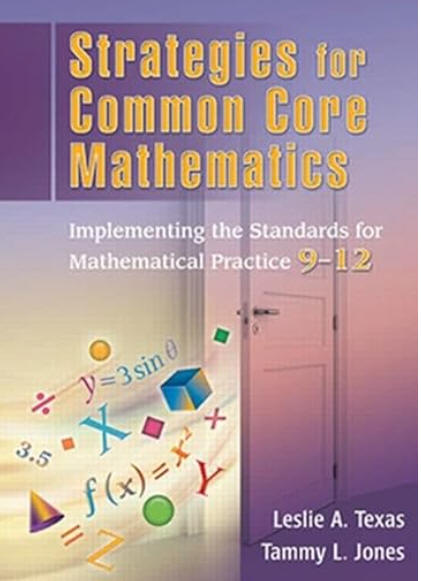 The
Common Core Math Book Bundle: Strategies for Common Core
Mathematics: Implementing the Standards for Mathematical Practice,
9-12 by Leslie Texas and Tammy Jones (2013) will benefit math educators.
They explain "each of the eight
mathematical practices and give high school educators specific
instructional strategies that align with the Common Core State
Standards for Mathematics."
The
Common Core Math Book Bundle: Strategies for Common Core
Mathematics: Implementing the Standards for Mathematical Practice,
9-12 by Leslie Texas and Tammy Jones (2013) will benefit math educators.
They explain "each of the eight
mathematical practices and give high school educators specific
instructional strategies that align with the Common Core State
Standards for Mathematics."
Common Core High School Math Reference Sheet for algebra 1, geometry, and algebra 2 will be helpful to learners, as it contains key measurement conversions and formulas.
Common Core Problem Based Learning Curriculum Maps for grades 3-8, integrated math for grades 9-11, algebra 1, geometry, and algebra 2 are provided by emergent math. Each unit of study has multiple problems and tasks mapped to the associated Common Core math standards.
Desmos Online Math Tools include Graphing, Scientific, Matrix, and Four Function calculators, and a Geometry Tool. Desmos also includes tutorials for what you can do with Desmos and classroom activities. Note: Desmos is included on over 30 state assessments. Desmos developed a suite of "Test Mode" apps to "help students and teachers prepare for these assessments—and to support delivery of lower-stakes tests and quizzes in classrooms." Users who desire an additional tutorial might read Desmos: A Definitive Guide on Graphing and Computing from Math Vault.
HOT!: eCalc Math Help Reference Sheets for algebra, geometry, trigonometry (definitions, laws, identities), and calculus (derivatives, limits, integrals) provide a quick review. There are six reference sheets in all with key definitions, properties, operations, and formulas in each subject, all in one file.
HOT for CCSS: Inside Mathematics: Common Core resources from The Dana Center, University of Texas include videos, tasks, and math problems for K-8 and high school. High school is listed by strand. The Inside Mathematics: Performance Assessment Tasks includes formative performance assessment tasks listed by grades 2-8 and high school algebra 1, geometry, and algebra 2. Tasks include scoring rubrics and discussion of student work examples. Resources are aligned to the CCSS math standards.
IXL Math contains multiple skill questions for each of the Common Core high school math standards. The site is subscription-based, but there is a free trial for teachers.
![]() Khan
Academy: Common Core aligned problems also feature step-by-step
solutions and videos related to problems to support learning.
Problems focus on conceptual understanding, procedural fluency, and
real-world application and are presented for K-8 and by high school
strand.
Khan
Academy: Common Core aligned problems also feature step-by-step
solutions and videos related to problems to support learning.
Problems focus on conceptual understanding, procedural fluency, and
real-world application and are presented for K-8 and by high school
strand.
Math Open Reference includes its alignment with the Common Core Math Standards and links to its resources related to those. Manipulatives are included.
Math Planet includes four courses: Pre-Algebra, Algebra 1, Algebra 2, and Geometry. Each comes with multiple chapters divided into several lesson topics. Under each lesson, you'll find theory, examples, and video lessons.
Math Warehouse has numerous animations, lessons, and interactive practice problems for algebra, geometry, trigonometry, and calculus.
Math Worksheets Land features worksheets with guided lessons that include the alignment of each to the Common Core standards. Worksheets are listed by topic and grade level. High school includes number & quantity, functions, algebra, geometry, and statistics & probability.
 Mathematics
Vision Project includes high school curriculum aligned to Common
Core standards. There are student texts and teacher editions
for Secondary I, II, and III, algebra, geometry, and algebra II. There are performance tasks and
"ready-set-go assignments." The series takes a multi-tasking
approach to learning. That is, each task addresses more than
one standard and each standard is addressed in more than one task.
Tasks are sequenced using the Comprehensive Mathematics Instruction
framework: develop understanding, solidify understanding, and
practice understanding.
Mathematics
Vision Project includes high school curriculum aligned to Common
Core standards. There are student texts and teacher editions
for Secondary I, II, and III, algebra, geometry, and algebra II. There are performance tasks and
"ready-set-go assignments." The series takes a multi-tasking
approach to learning. That is, each task addresses more than
one standard and each standard is addressed in more than one task.
Tasks are sequenced using the Comprehensive Mathematics Instruction
framework: develop understanding, solidify understanding, and
practice understanding.
Mathispower4u by James Sousa contains a collection of over 6000 mini-lessons and videos organized by course and topic: number sense, arithmetic/prealgebra, algebra 1, algebra 2, geometry, math for liberal arts, trigonometry, calculus 1, calculus 2, calculus 3, linear algebra, differential equations. The site also includes problem solving activities with video solutions. Multiple Common Core topics are addressed in these.
HOT!: National Science Digital Library emphasizes STEM resources for K-12 and beyond. You will find over 3000 resources related to the Common Core Math Standards and can refine your search by grade level, learning domain, and alignment. In general, search options include by education level, resource type, subject, standards, and an advanced search option to further narrow what you are looking for. Most are open educational resources.
PBS LearningMedia includes free media resources searchable by grade level, standards, media type, and subject. Resources include video and audio segments, interactives, images, documents, lesson plans, productivity tools for teachers, self-paced lessons,and student-oriented activities. You'll find media from NOVA, Frontline, American Experience, and other public broadcasting and content partners. The mathematics section features K-8 mathematics strands, and high school number and quantity, algebra, geometry, functions, statistics and probability. Highly recommended.
Symbolab offers multiple calculators that allow users to search and solve equations, formulas and expressions using mathematical symbols and scientific notations as well as text. It includes step-by-step calculators for pre-algebra, algebra, functions, geometry, statistics, trigonometry, matrices and vectors, pre-calculus, calculus, finance and conversion topics covered in middle school math through college. The site offers a graphing calculator. Symbolab also solves math word problems and can generate worksheets.
TI Math includes multiple activities for using the TI-84 calculator with learners. Activities are grouped by content area: Middle Grades Math, Algebra I, Geometry, Algebra 2, Precalculus, Calculus, Statistics and Math Modeling.
Wolfram Demonstration Project has amassed an extensive collection of "demonstrations" in multiple topics. Mathematics can be filtered by school mathematics and subject. See all the demonstrations in alphabetical order.
See additional Common Core Content Resources on CT4ME within our math methodology curriculum resources.
Lack of understanding in math may be due to lack of understanding of the vocabulary. CT4ME recommends that learners develop math vocabulary by creating their own vocabulary cards to include the word, its definition in their own words, examples and non-examples of the word, and characteristics and facts about the word, such as would be found using the Frayer Model. The Wisconsin Department of Public Instruction includes a downloadable form for the Frayer Model that students can use.
| Frayer Model | |
| Definition |
Characteristics Facts |
|
Word or Concept |
|
| Examples | Non-Examples |
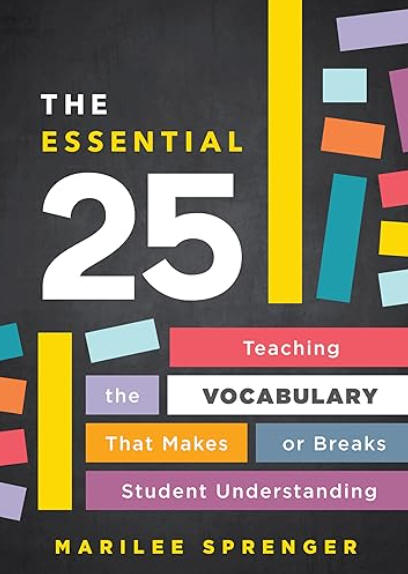 In addition to math vocabulary, students should also know key vocabulary
found on standardized tests. In
The essential 25: Teaching the vocabulary that
makes or breaks student understanding Marilee Sprenger (2021) shared
her "list of 25 essential high-frequency words that are used in standardized
assessments and other academic contexts across states and grade levels."
They Include: "analyze, cite, compare, contrast, demonstrate,
describe, details, determine, develop, distinguish, evaluate, evidence, explain,
infer, interpret, main idea, paraphrase, persuade, point of view, relevant,
structure, summarize, support, theme, and trace" (Introduction section).
Such words are not typical of everyday speech.
In addition to math vocabulary, students should also know key vocabulary
found on standardized tests. In
The essential 25: Teaching the vocabulary that
makes or breaks student understanding Marilee Sprenger (2021) shared
her "list of 25 essential high-frequency words that are used in standardized
assessments and other academic contexts across states and grade levels."
They Include: "analyze, cite, compare, contrast, demonstrate,
describe, details, determine, develop, distinguish, evaluate, evidence, explain,
infer, interpret, main idea, paraphrase, persuade, point of view, relevant,
structure, summarize, support, theme, and trace" (Introduction section).
Such words are not typical of everyday speech.
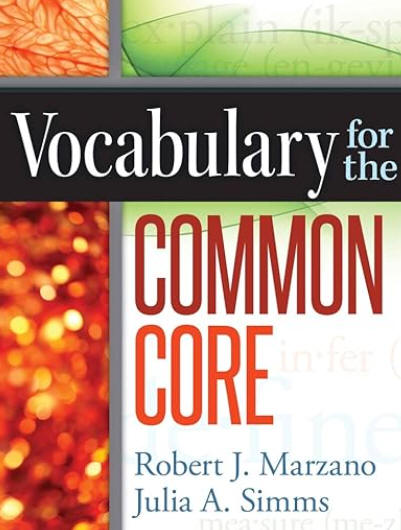 Vocabulary
for the Common Core by Robert Marzano and Julie Simms (2013) will help educators to
incorporate CCSS vocabulary into teaching and learning. Among
its goals is for readers to be able to make general academic and
domain specific language from the CCSS relevant to students.
Vocabulary
for the Common Core by Robert Marzano and Julie Simms (2013) will help educators to
incorporate CCSS vocabulary into teaching and learning. Among
its goals is for readers to be able to make general academic and
domain specific language from the CCSS relevant to students.
Granite School District in Salt Lake City, Utah, includes math vocabulary organized by grade level (K-8 and secondary including for the Common Core standards, and dual immersion) and resources for teaching vocabulary development. Select the following for the secondary level, which match the Common Core:
Mathwords.com features "terms and formulas from beginning algebra to calculus." Terms include appropriate pictures, diagrams, tables, and examples and are indexed by subject area: numbers and symbols; sets, logic, proof; geometry, algebra, trigonometry, advanced algebra and precalculus, calculus, advanced topics, probability and statistics, real world applications. Entries that feature multimedia are noted.
Partners for Learning: Common Core Math Academic Vocabulary Words for K-12 arranged by grade level and standard with the definition of each. The pdf has over 120 pages. You'll also find general grade level math words.
Stat Trek Statistics Dictionary
Virginia Department of Education Mathematics Vocabulary Word Wall Cards for grades K-8, algebra 1, geometry, algebra 2; and algebra, functions and data analysis. The "Mathematics vocabulary word wall cards provide a display of mathematics content words and associated visual cues to assist in vocabulary development." The Virginia Department of Education also indicated that the "cards should be used as an instructional tool for teachers and then as a reference for all students, particularly English learners and students with disabilities."
Wolfram MathWorld has multiple categories leading to vocabulary related to algebra, geometry, statistics and probability, number theory, and more.
 You can find out by using
Benchmark Now!, a free online tool from Naiku for Grades
2-High School. It "combines the assessment delivery,
auto-scoring, and intuitive standards-based reporting features of
Naiku with professionally developed end-of-year summative
assessments that include a variety of question item types –
including technology enhanced – tied to the Common Core State
Standards in ELA and Math."
You can find out by using
Benchmark Now!, a free online tool from Naiku for Grades
2-High School. It "combines the assessment delivery,
auto-scoring, and intuitive standards-based reporting features of
Naiku with professionally developed end-of-year summative
assessments that include a variety of question item types –
including technology enhanced – tied to the Common Core State
Standards in ELA and Math."
For testing in your state and sample test items, see our CT4ME section for Standardized Test Preparation.
ASCD Policy Points (2013, October) dispels myths surrounding the CCSS, so that parents, educators, policymakers, and the general public have a better understanding of what the standards are and are not. Read Myths and Facts.
 Note:
Membership in the PARCC and SBAC consortia has decreased since 2010.
Many states are working to develop their own summative assessments.
New Meridian assists states in
this endeavor.
Note:
Membership in the PARCC and SBAC consortia has decreased since 2010.
Many states are working to develop their own summative assessments.
New Meridian assists states in
this endeavor.
PARCC
New Meridian took over management of PARCC's testing business in 2017. Find released test items among its resources. See: PARCC Agent Rolling Out Pool of Items for Custom State Assessments by Dian Schaffhauser (2018, December 6).
Under its resource for Math Test Design, New Meridian includes test specifications, performance-level descriptors, evidence statements including calculator designations, and a Mathematics High Level Blueprint that "defines the total number of tasks and/or items for any given grade/course assessment, the item types, and the point values for each. These are intended to help the "general public better understand the design of the state summative assessments." New Meridian also includes a section on accessibility and how it is incorporating universal design and accessibility features and accommodations into assessments.
The Smarter Balanced Assessment Consortium (SBAC) includes summative assessments for accountability purposes and optional interim assessments for instructional use and will use computer adaptive testing to the greatest extent possible. Assessments go beyond multiple choice questions to include extended response and technology enhanced items, as well as performance tasks that allow students to demonstrate critical-thinking and problem-solving skills. See SBAC Practice Tests and Sample Questions.
Read about SBAC's Accessibility Resources and Accommodations that outline the kinds of testing supports and tools that are made available to all students, and particularly those with disabilities and English-language learners.
SBAC Testing Technology Information
Read about and test out SBAC's built-in calculators, powered by Desmos.
![]()
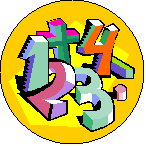 Domains: Click on a domain to find technology
investigations, multiple choice and constructed response exercises, and
performance tasks.
Domains: Click on a domain to find technology
investigations, multiple choice and constructed response exercises, and
performance tasks.
General:
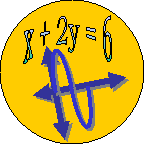 Domains: Click on a domain to find technology
investigations, multiple choice and constructed response exercises, and
performance tasks.
Domains: Click on a domain to find technology
investigations, multiple choice and constructed response exercises, and
performance tasks.
General:
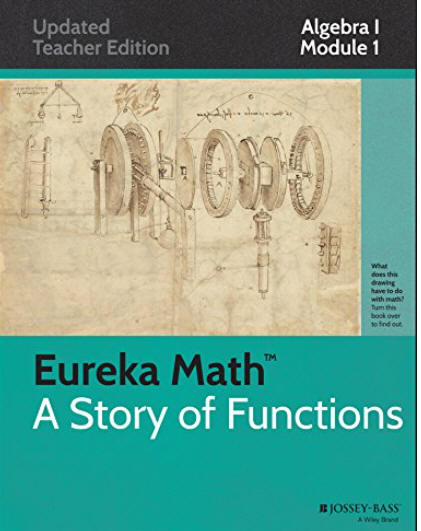 Eureka Math, A Story of Functions: Algebra I, Module I:
Relationships Between Quantities and Reasoning with Equations and Their Graphs
by Common Core (2013) contains lessons combining conceptual
understanding, fluency, and application. Formative assessments are
included. Content in Module 1 addresses standards: N-Q.1, N-Q.2,
N-Q.3, A-SSE.1, A-SSE.2, A-APR.1, A-CED.1, A-CED.2, A-CED.3,
A-CED.4, A-REI.1, A-REI.3, A-REI.5, A-REI.6, A-REI.10, A-REI.12.
Eureka Math, A Story of Functions: Algebra I, Module I:
Relationships Between Quantities and Reasoning with Equations and Their Graphs
by Common Core (2013) contains lessons combining conceptual
understanding, fluency, and application. Formative assessments are
included. Content in Module 1 addresses standards: N-Q.1, N-Q.2,
N-Q.3, A-SSE.1, A-SSE.2, A-APR.1, A-CED.1, A-CED.2, A-CED.3,
A-CED.4, A-REI.1, A-REI.3, A-REI.5, A-REI.6, A-REI.10, A-REI.12.
 Domains: Click on a domain to find technology
investigations, multiple choice and constructed response exercises, and
performance tasks.
Domains: Click on a domain to find technology
investigations, multiple choice and constructed response exercises, and
performance tasks.
General:
Eureka Math, A Story of Functions: Algebra I, Module 3, Module 4, and Module 5 by Common Core (2014) contain lessons combining conceptual understanding, fluency, and application. Formative assessments are included:
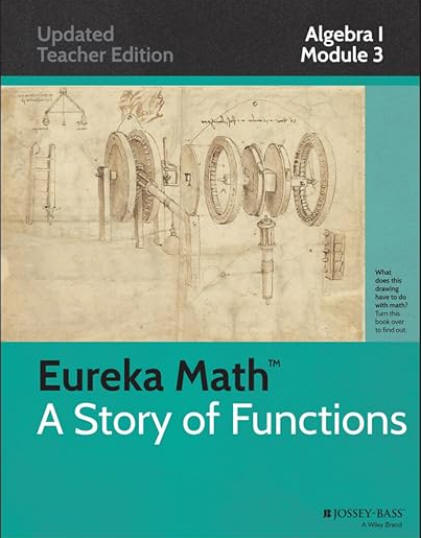 Module 3: Linear and Exponential Functions
addresses standards: A-SSE.3, A-CED.1, A.REI.11, F-IF.1,
F-IF.2, F-IF.3, F-IF.4, F-IF.5, F-IF.6, F-IF.7, F-IF.9,
F-BF.1, F-BF.3, F-LE.1, F-LE.2, F-LE.3, F-LE.5.
Module 3: Linear and Exponential Functions
addresses standards: A-SSE.3, A-CED.1, A.REI.11, F-IF.1,
F-IF.2, F-IF.3, F-IF.4, F-IF.5, F-IF.6, F-IF.7, F-IF.9,
F-BF.1, F-BF.3, F-LE.1, F-LE.2, F-LE.3, F-LE.5.
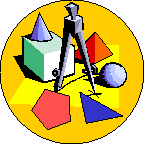 Domains: Click on a domain to find technology
investigations, multiple choice and constructed response exercises, and
performance tasks.
Domains: Click on a domain to find technology
investigations, multiple choice and constructed response exercises, and
performance tasks.
General:
 Domains: Click on a domain to find technology
investigations, multiple choice and constructed response exercises, and
performance tasks.
Domains: Click on a domain to find technology
investigations, multiple choice and constructed response exercises, and
performance tasks.
General:
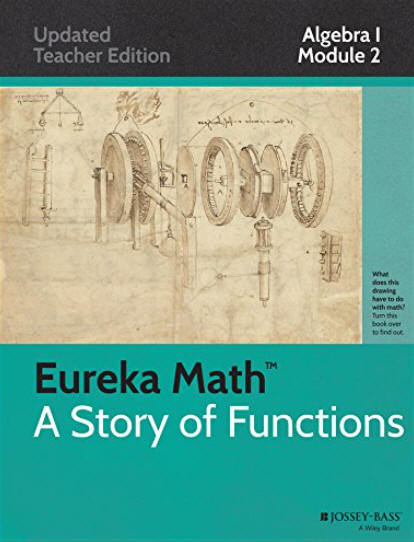 Eureka Math, A Story of Functions: Algebra 1, Module 2:
Descriptive Statistics by Common Core (2013) contains lessons combining conceptual
understanding, fluency, and application. Formative assessments are
included. Content in Module 2 addresses standards: S-ID.1, S-ID.2,
S-ID.3, S-ID.5, S-ID.6, S-ID.7, S-ID.8, S-ID.9.
Eureka Math, A Story of Functions: Algebra 1, Module 2:
Descriptive Statistics by Common Core (2013) contains lessons combining conceptual
understanding, fluency, and application. Formative assessments are
included. Content in Module 2 addresses standards: S-ID.1, S-ID.2,
S-ID.3, S-ID.5, S-ID.6, S-ID.7, S-ID.8, S-ID.9.
 In Technology Readiness for College and Career Ready Teaching,
Learning and Assessment, the State Educational Technology Directors
Association (2012) reminded educators that:
In Technology Readiness for College and Career Ready Teaching,
Learning and Assessment, the State Educational Technology Directors
Association (2012) reminded educators that:
"Digital testing requires digital learning. Students using technology to take high--stakes tests must have significant opportunities to develop and demonstrate master of tested knowledge, skills and abilities via substantially similar technology prior to being tested. Teachers must be prepared to support this shift in instruction" (p. 1).
CT4ME has multiple resources to help with this endeavor.
Common Core State Standards. (2010). Mathematics Standards. Washington, DC: National Governors Association Center for Best Practices, Council of Chief State School Officers. https://www.thecorestandards.org/Math/
Polikoff, M.S., Petrilli, M.J., & Loveless, T. (2020). A decade on, has Common Core failed? Assessing the impact of national standards. Education Next, 20(2), 72-81. https://www.educationnext.org/wp-content/uploads/2022/01/ednext_XX_2_forum.pdf
Sprenger, M. (2021). The essential 25: Teaching the vocabulary that makes or breaks student understanding. Alexandria, VA: ASCD. Available: https://amzn.to/3ADdKZe
State Educational Technology Directors Association. (2012). Technology Readiness for College and Career Ready Teaching, Learning and Assessment. https://web.archive.org/web/20240627033200/http://www.setda.org/master/wp-content/uploads/2013/09/SETDA_TechnologyReadinessCollege.pdf